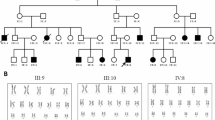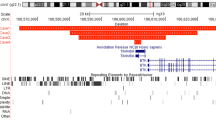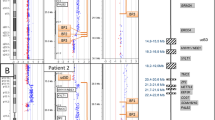Abstract
Chromosomal microdeletions represent a complex class of genetic disorders. Recently, 16p13.3 microdeletions encompassing TBC1D24 and ATP6V0C have gained prominence as structural variants associated with neurodevelopmental disorders, but their occurrence mechanisms remain unexplored. We used a comprehensive range of sequencing technologies (mate pair genome sequencing, linked-pair genome sequencing, nanopore sequencing, targeted locus amplification (TLA), long range and nested PCR followed by Sanger sequencing), to map the exact 16p13.3 microdeletion breakpoints in eight previously reported individuals. Microdeletion breakpoints were successfully mapped in all patients using TLA, split read analysis, PCR/Sanger sequencing, or nanopore sequencing. Alu sequences and/or non-B DNA motifs were detected in all patients. Mechanistic analysis identified distinct pathways underlying these rearrangements. Noteworthy, two unrelated individuals carried identical microdeletions that might have been mediated by an atypical form of non-allelic homologous recombination, given the presence of a 639 bp sequence with 96.2% homology. Microhomology-mediated end-joining and non-homologous end-joining emerged as other mechanisms driving these 16p13.3 microdeletions, which differs from other studied contiguous gene deletion syndromes. This research contributes to a deeper understanding of microdeletion-associated disorder pathophysiology in medical genetics.
This is a preview of subscription content, access via your institution
Access options
Subscribe to this journal
Receive 12 print issues and online access
$259.00 per year
only $21.58 per issue
Buy this article
- Purchase on SpringerLink
- Instant access to full article PDF
Prices may be subject to local taxes which are calculated during checkout


Similar content being viewed by others
Data availability
The data that support the findings of this study are available from the corresponding author upon reasonable request.
References
Kumar D. Disorders of the genome architecture: a review. Genom Med. 2008;2:69–76. https://doi.org/10.1007/s11568-009-9028-2.
Shaw CJ, Lupski JR. Non-recurrent 17p11.2 deletions are generated by homologous and non-homologous mechanisms. Hum Genet. 2005;116:1–7. https://doi.org/10.1007/s00439-004-1204-9.
Verdin H, D’haene B, Beysen D, Novikova Y, Menten B, Sante T, et al. Microhomology-mediated mechanisms underlie non-recurrent disease-causing microdeletions of the FOXL2 gene or its regulatory domain. PLoS Genet. 2013;9:e1003358 https://doi.org/10.1371/journal.pgen.1003358.
Gu W, Zhang F, Lupski JR. Mechanisms for human genomic rearrangements. Pathogenetics. 2008;1: https://doi.org/10.1186/1755-8417-1-4.
Gu S, Yuan B, Campbell IM, Beck CR, Carvalho CMB, Nagamani SCS, et al. Alu-mediated diverse and complex pathogenic copy-number variants within human chromosome 17 at p13.3. Hum Mol Genet. 2015;24:4061–77. https://doi.org/10.1093/hmg/ddv146.
Song X, Beck CR, Du R, Campbell IM, Coban-Akdemir Z, Gu S, et al. Predicting human genes susceptible to genomic instability associated with Alu/Alu-mediated rearrangements. Genome Res. 2018;28:1228–42. https://doi.org/10.1101/gr.229401.117.
Korbel JO, Urban AE, Affourtit JP, Godwin B, Grubert F, Simons JF, et al. Paired-end mapping reveals extensive structural variation in the human genome. Science. 2007;318:420–6. https://doi.org/10.1126/science.1149504.
Chen J-M, Cooper DN, Férec C, Kehrer-Sawatzki H, Patrinos GP. Genomic rearrangements in inherited disease and cancer. Semin Cancer Biol. 2010;20:222–33. https://doi.org/10.1016/j.semcancer.2010.05.007.
Carvalho CM, Lupski JR. Mechanisms underlying structural variant formation in genomic disorders. Nat Rev Genet. 2016;17:224–38. https://doi.org/10.1038/nrg.2015.25.
Mucha BE, Banka S, Ajeawung NF, Molidperee S, Chen GG, Koenig MK, et al. A new microdeletion syndrome involving TBC1D24, ATP6V0C, and PDPK1 causes epilepsy, microcephaly, and developmental delay. Genet Med. 2019;21:1058–64. https://doi.org/10.1038/s41436-018-0290-3.
Bartsch O, Rasi S, Delicado A, Dyack S, Neumann LM, Seemanová E, et al. Evidence for a new contiguous gene syndrome, the chromosome 16p13.3 deletion syndrome alias severe Rubinstein–Taybi syndrome. Hum Genet. 2006;120:179–86. https://doi.org/10.1007/s00439-006-0215-0.
Balestrini S, Campeau PM, Mei D, Guerrini R, Sisodiya S. TBC1D24-Related Disorders. In Adam MP editor GeneReviews®. Seattle: University of Washington; 2015.
Mattison KA, Tossing G, Mulroe F, Simmons C, Butler KM, Schreiber A, et al. ATP6V0C variants impair V-ATPase function causing a neurodevelopmental disorder often associated with epilepsy. Brain. 2023;146:1357–72. https://doi.org/10.1093/brain/awac330.
Tinker RJ, Burghel GJ, Garg S, Steggall M, Cuvertino S, Banka S. Haploinsufficiency of ATP6V0C possibly underlies 16p13.3 deletions that cause microcephaly, seizures, and neurodevelopmental disorder. Am J Med Genet A. 2021;185:196–202. https://doi.org/10.1002/ajmg.a.61905.
Talkowski ME, Ernst C, Heilbut A, Chiang C, Hanscom C, Lindgren A, et al. Next-generation sequencing strategies enable routine detection of balanced chromosome rearrangements for clinical diagnostics and genetic research. Am J Hum Genet. 2011;88:469–81. https://doi.org/10.1016/j.ajhg.2011.03.013.
Hottentot QP, van Min M, Splinter E, White SJ. Targeted locus amplification and next-generation sequencing. In: Methods in molecular biology. New York, NY: Springer New York; 2017. p. 185–96.
Koressaar T, Remm M. Enhancements and modifications of primer design program Primer3. Bioinforma. 2007;23:1289–91. https://doi.org/10.1093/bioinformatics/btm091.
Tsai M-F, Lin Y-J, Cheng Y-C, Lee K-H, Huang C-C, Chen Y-T, et al. PrimerZ: streamlined primer design for promoters, exons and human SNPs. Nucleic Acids Res. 2007;35:W63–W65. https://doi.org/10.1093/nar/gkm383.
Untergasser A, Cutcutache I, Koressaar T, Ye J, Faircloth BC, Remm M, et al. Primer3—new capabilities and interfaces. Nucleic Acids Res. 2012;40:e115–e115. https://doi.org/10.1093/nar/gks596.
Ye J, Coulouris G, Zaretskaya I, Cutcutache I, Rozen S, Madden TL. Primer-BLAST: a tool to design target-specific primers for polymerase chain reaction. BMC Bioinformatics. 2012;13: https://doi.org/10.1186/1471-2105-13-134.
Kent WJ. BLAT—the BLAST-like alignment tool. Genome Res. 2002;12:656–64. https://doi.org/10.1101/gr.229202.
Kent WJ, Sugnet CW, Furey TS, Roskin KM, Pringle TH, Zahler AM, et al. The human genome browser at UCSC. Genome Res. 2002;12:996–1006. https://doi.org/10.1101/gr.229102.
Paré B, Rozendaal M, Morin S, Kaufmann L, Simpson SM, Poujol R, et al. Patient health records and whole viral genomes from an early SARS-CoV-2 outbreak in a Quebec hospital reveal features associated with favorable outcomes. PLoS One. 2021;16:e0260714 https://doi.org/10.1371/journal.pone.0260714.
Delehelle F, Cussat-Blanc S, Alliot J-M, Luga H, Balaresque P. ASGART: fast and parallel genome scale segmental duplications mapping. Bioinforma. 2018;34:2708–14. https://doi.org/10.1093/bioinformatics/bty172.
Cer RZ, Bruce KH, Mudunuri US, Yi M, Volfovsky N, Luke BT, et al. Non-B DB: a database of predicted non-B DNA-forming motifs in mammalian genomes. Nucleic Acids Res. 2011;39:D383–D391. https://doi.org/10.1093/nar/gkq1170.
Cer RZ, Donohue DE, Mudunuri US, Temiz NA, Loss MA, Starner NJ, et al. Non-B DB v2.0: a database of predicted non-B DNA-forming motifs and its associated tools. Nucleic Acids Res. 2012;41:D94–D100. https://doi.org/10.1093/nar/gks955.
Cer RZ, Bruce KH, Donohue DE, Temiz NA, Mudunuri US, Yi M, et al. Searching for non-B DNA-forming motifs using nBMST (non-B DNA Motif Search Tool). Curr Protoc Hum Genet. 2012;73: https://doi.org/10.1002/0471142905.hg1807s73.
Bansal A, Kaushik S, Kukreti S. Non-canonical DNA structures: diversity and disease association. Front Genet. 2022;13:959258. https://doi.org/10.3389/fgene.2022.959258.
Duardo RC, Guerra F, Pepe S, Capranico G. Non-B DNA structures as a booster of genome instability. Biochimie. 2023;214:176–92. https://doi.org/10.1016/j.biochi.2023.07.002.
Sievers F, Wilm A, Dineen D, Gibson TJ, Karplus K, Li W, et al. Fast, scalable generation of high-quality protein multiple sequence alignments using Clustal Omega. Mol Syst Biol. 2011;7: https://doi.org/10.1038/msb.2011.75.
Sievers F, Higgins DG. Clustal Omega for making accurate alignments of many protein sequences. Protein Sci. 2018;27:135–45. https://doi.org/10.1002/pro.3290.
Brown NP, Leroy C, Sander C. MView: a web-compatible database search or multiple alignment viewer. Bioinforma. 1998;14:380–1. https://doi.org/10.1093/bioinformatics/14.4.380.
Bacolla A, Wells RD. Non-B DNA conformations, genomic rearrangements, and human disease. J Biol Chem. 2004;279:47411–4. https://doi.org/10.1074/jbc.r400028200.
Kaushal S, Freudenreich CH. The role of fork stalling and DNA structures in causing chromosome fragility. Genes Chromosomes Cancer. 2019;58:270–83. https://doi.org/10.1002/gcc.22721.
Sen SK, Han K, Wang J, Lee J, Wang H, Callinan PA, et al. Human genomic deletions mediated by recombination between Alu elements. Am J Hum Genet. 2006;79:41–53. https://doi.org/10.1086/504600.
Waldman AS, Liskay RM. Dependence of intrachromosomal recombination in mammalian cells on uninterrupted homology. Mol Cell Biol. 1988;8:5350–7. https://doi.org/10.1128/mcb.8.12.5350-5357.1988.
Rubnitz J, Subramani S. The minimum amount of homology required for homologous recombination in mammalian cells. Mol Cell Biol. 1984;4:2253–8. https://doi.org/10.1128/mcb.4.11.2253-2258.1984.
Lieber MR. The mechanism of human nonhomologous DNA end joining. J Biol Chem. 2008;283:1–5. https://doi.org/10.1074/jbc.r700039200.
Boyer A-S, Grgurevic S, Cazaux C, Hoffmann J-S. The human specialized DNA polymerases and non-B DNA: vital relationships to preserve genome integrity. J Mol Biol. 2013;425:4767–81. https://doi.org/10.1016/j.jmb.2013.09.022.
Xu Y, Komiyama M. G-quadruplexes in human telomere: structures, properties, and applications. Molecules. 2023;29:174 https://doi.org/10.3390/molecules29010174.
Georgakopoulos-Soares I, Victorino J, Parada GE, Agarwal V, Zhao J, Wong HY, et al. High-throughput characterization of the role of non-B DNA motifs on promoter function. Cell Genomics. 2022;2:100111. https://doi.org/10.1016/j.xgen.2022.100111.
De Cario R, Kura A, Suraci S, Magi A, Volta A, Marcucci R, et al. Sanger validation of high-throughput sequencing in genetic diagnosis: still the best practice? Front Genet. 2020;11: https://doi.org/10.3389/fgene.2020.592588.
Walz K, Fonseca P, Lupski JR. Animal models for human contiguous gene syndromes and other genomic disorders. Genet Mol Biol. 2004;27:305–20. https://doi.org/10.1590/s1415-47572004000300001.
Theisen A, Shaffer LG. Disorders caused by chromosome abnormalities. Appl Clin Genet. 2010;159: https://doi.org/10.2147/tacg.s8884.
Zhao B, Rothenberg E, Ramsden DA, Lieber MR. The molecular basis and disease relevance of non-homologous DNA end joining. Nat Rev Mol Cell Biol. 2020;21:765–81. https://doi.org/10.1038/s41580-020-00297-8.
Acknowledgements
We thank the patients and their families for taking part in the study. We also thank the physicians who contributed to our initial microdeletion study.
Funding
This work was supported by Canadian Institutes of Health Research (CIHR) grant 137093.
Author information
Authors and Affiliations
Contributions
BM and EAC wrote the manuscript and were responsible for data collection and interpretation. EAC, SK, NFA, DAJC, SE, GC and CE contributed to the data collection and data interpretation. BM, PMC and JR contributed to the data collection, data interpretation, writing, review, and editing of the manuscript. All authors reviewed and approved the latest version of the manuscript.
Corresponding author
Ethics declarations
Competing interests
The authors declare no competing interests.
Ethical approval
This study was approved by an institutional review board and adheres to the tenets of the Declaration of Helsinki. Written informed consent was obtained from all individuals before participation in the study.
Additional information
Publisher’s note Springer Nature remains neutral with regard to jurisdictional claims in published maps and institutional affiliations.
Supplementary information
Rights and permissions
Springer Nature or its licensor (e.g. a society or other partner) holds exclusive rights to this article under a publishing agreement with the author(s) or other rightsholder(s); author self-archiving of the accepted manuscript version of this article is solely governed by the terms of such publishing agreement and applicable law.
About this article
Cite this article
Mazel, B., Coleman, E.A., Rousseau, J. et al. Mechanistic insights into 16p13.3 microdeletions encompassing TBC1D24 and ATP6V0C through advanced sequencing approaches. Eur J Hum Genet 33, 1136–1143 (2025). https://doi.org/10.1038/s41431-025-01912-y
Received:
Revised:
Accepted:
Published:
Issue date:
DOI: https://doi.org/10.1038/s41431-025-01912-y
This article is cited by
-
What’s new in EJHG this autumn
European Journal of Human Genetics (2025)



